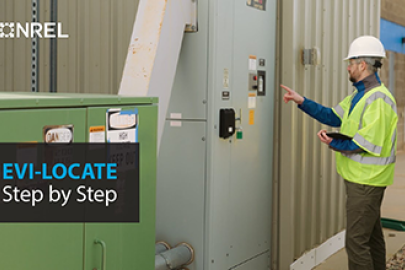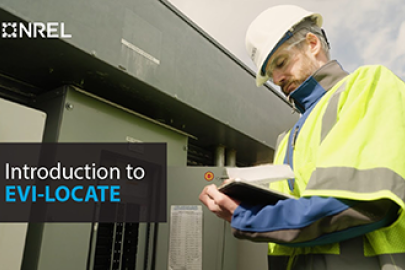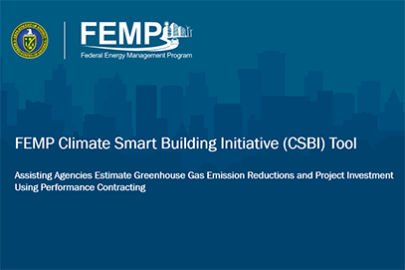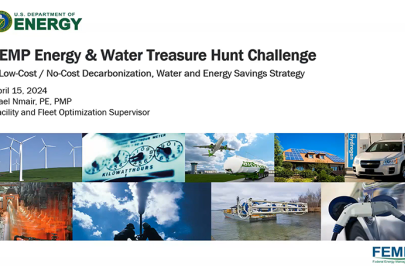This training focuses on energy efficiency requirements for federal acquisitions. We'll show you how to find the energy efficient purchasing requirements for a specific product/service, and other helpful resources.
Federal Energy Management Program
February 15, 2024Got five minutes? The Take Five training series has you covered with very short trainings in buying clean, efficient goods and services for the federal government while doing your part to reduce carbon emissions.
This training focuses on energy efficiency requirements for federal acquisitions. We'll show you how to find the energy efficient purchasing requirements for a specific product or service, and introduce you to the Paths to Energy Efficiency Requirements (PEER) Tool—an interactive PDF that can be used to look up energy efficiency requirements and suggested contract language for any product or service purchased for federal use.
Hello and welcome to Take Five, a series of quick lessons in sustainable purchasing. I'm Meena Venkatraman of Berkeley Lab, and today I'll cover how you can quickly learn about and help communicate energy efficiency requirements for an acquisition. Since the U.S. government is the nation's largest energy consumer, federal agencies have a unique opportunity to reduce energy, carbon emissions, and save taxpayer dollars by buying efficient products and services. Buying the right efficient product for your agency can take time, and we want to make it as easy as possible. So in this training, we'll show you how to find the energy efficient purchasing requirements for a specific product/service and other helpful resources in just a few clicks.
So why buy energy efficient products?
Federal agencies are required to purchase products that are either certified by the Environmental Protection Agency's ENERGY STAR program or meet an efficiency level designated by the Department of Energy's Federal Energy Management Program (FEMP). The two programs cover different products, sizes, and applications. These requirements are written into statute and have an associated FAR clause. They apply not only to energy-using products, but also to any services that involve energy-using products. Buying efficient products can also provide energy and cost savings, and reduce the emissions intensity of your site, helping your agency meet required cuts in energy and greenhouse gas emissions.Who's job is it, though, to make sure your agency is buying efficient products? Is it the contracting officer or program manager? Is it agency leadership, or is it one of the many roles that request products and services?
Meeting the requirements is everyone's responsibility. Whether you're asking for a product, doing market research or writing a solicitation, make sure it's a compliant product. You have a critical role to play in ensuring your agency purchases the best product to meet the agency mission, comply with federal law, and help address climate change.
But sometimes challenges can arise. Perhaps someone requests a product, and it may not be compliant. Or buying efficient products doesn't seem like a high priority for your agency. Maybe a supplier proposed a non-compliant product. Or you might even be wondering at this stage…what efficiency requirements apply?
To make things easier, we created this simple tool—Paths to Energy Efficiency Requirements or PEER—which is one way you can learn about and share the requirements within your agency. Basically, whether you're looking for a product or service, if it uses energy, then PEER will provide links to the requirements, product information, and sample contract language—just answer a few questions in this PDF.
Let's go through a couple examples. Let's say your agency needs an air-cooled electric chiller, a common cooling technology for small to mid-sized office buildings. You open up the PEER PDF. A chiller is a product, it's energy-consuming—meaning it's powered by electricity or another fuel. So it should meet either the ENERGY STAR or FEMP-designated efficiency requirements, Next, select the HVAC/mechanical category. The link takes you to SFTool, a federal green building and procurement website developed by the General Services Administration. Or look up SFTool.gov to get there directly. Here you can select Chillers, and the Procurement Info section provides the requirement and sample contract language. Chillers are FEMP-designated, so you can check this link to the FEMP product page to find the required efficiency level. On this page you can also find cost savings and tips for choosing the right chiller for a typical federal application.
Let's try another case. Your agency wants to build a new facility. Back in the PEER PDF, you would now select construction services. If you know the products that will be purchased, the links here will take you to SFTool as we saw earlier. Even if you're unsure what products will be purchased, you still need to meet the efficiency requirements, and PEER provides resources that can help you comply.It's that easy! You can attach this document to an email, put it up on your website or save it to your computer. And you can share PEER with anyone—up and down the procurement chain, since everyone has their role to play in meeting the requirements.
Here's a few more quick tips for buying a compliant product. Pre-award, you can inform the product or service requestor of the requirements—this is where PEER comes in handy. During market research, identify suppliers that can meet the requirements, and in pre-award documents you can include language that notifies suppliers about the requirements. In a solicitation, beyond including the relevant FAR clause, you can specify a compliant product or the required efficiency level in the technical specifications. You can also require offers to document compliance and include efficiency requirements among the evaluation factors. Together, the PEER tool and these steps can help you find the efficiency requirements and make sure every purchase is a compliant one.
To learn more, check out some of our other training, such as our previous Take Five videos on buying air-source heat pumps and buying energy-efficient lighting. For more in-depth information, see our full length Contracting for Efficiency training. Thanks for tuning in to this edition of Take Five, and thank you for doing your part to meet federal policy, save taxpayer dollars, and address climate change.
Download a one-page guide to federal acquisition requirements.
Learn more about Energy-Efficient Product Procurement Training for Federal Agencies.










